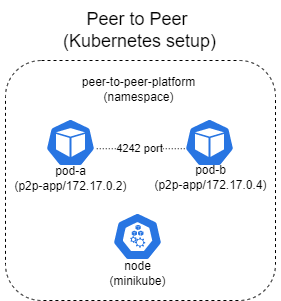It's assumed that these software are installed and running:
minikube version
Create a cluster with two nodes.
minikube start --driver=docker --nodes 2 -p demokubectl get nodesAdd labels to both nodes.
kubectl label nodes demo nodelabel=node-01kubectl label nodes demo-m02 nodelabel=node-02kubectl get nodes --show-labelsTwo Pods were created to accommodate the p2p-app. Which is a Rust application using the libp2p ping protocol to test the connectivity and performance between these two Pods. For each Pod a image is created and deployed into the container inside of the corresponding Pod.
docker build -f /p2p-setup/pod-a-dockerfile.dev -t p2p-pod-a:1.0 .Note : to list images just run "docker image ls"
docker tag p2p-pod-a:1.0 {docker.hub}/p2p-pod-a:1.0docker push {docker.hub}/p2p-pod-a:1.0docker build -f /p2p-setup/pod-b-dockerfile.dev -t p2p-pod-b:1.0 .docker tag p2p-pod-b:1.0 {docker.hub}/p2p-pod-b:1.0docker push {docker.hub}/p2p-pod-b:1.0kubectl apply -f 1_namespace.ymlNote: to list the namespaces just run "kubectl get namespaces"
kubectl apply -f 2_pod-a.ymlkubectl logs -f pod-a --namespace=peer-to-peer-platformkubectl apply -f 3_pod-b.ymlkubectl logs -f pod-b --namespace=peer-to-peer-platformFor this scenario we are going to create a node with two pods. Each pod will have two containers. The mDNS protocol is not able to discover devices outside the pod local network.
docker build -f /peer-to-peer/kubernetes-setup/2_scenario_mdns-app/mdns-app-dockerfile.dev -t mdns-app:1.0 .docker tag mdns-app:1.0 {docker.hub}/mdns-app:1.0docker push {docker.hub}/mdns-app:1.0kubectl apply -f 1_namespace.ymlNote: to list the namespaces just run "kubectl get namespaces"
Create a pod "pod-a" with two containers "container-a" & "container-b".
kubectl apply -f 2_pod-a.ymlCreate a pod "pod-b" with two containers "container-a" & "container-b".
kubectl apply -f 3_pod-b.ymlkubectl get pod -o wide --namespace=peer-to-peer-platformVerify the logs for the container "container-a" inside of the pod "pod-a".
kubectl logs pod-a -c container-a --namespace=peer-to-peer-platformVerify the logs for the container "container-b" inside of the pod "pod-a".
kubectl logs pod-a -c container-b --namespace=peer-to-peer-platformVerify the logs for the container "container-a" inside of the pod "pod-b".
kubectl logs pod-b -c container-a --namespace=peer-to-peer-platformVerify the logs for the container "container-b" inside of the pod "pod-b".
kubectl logs pod-b -c container-b --namespace=peer-to-peer-platformDelete all resources belonging to the namespace.
kubectl delete namespace peer-to-peer-platformFor this scenario we are going to create a cluster with two nodes, with two pods each. For the mDNS protocol to discover devices outside the pod local network. The HostNetwork is set to true(hostNetwork: true) to allow a pod to use the node network namespace. This was done for pod-a and pod-c. The network behavior is composed by the mDNS protocol for discovery and Kademlia for storing the IPs of the peers found and providers.
docker build -f /peer-to-peer/kubernetes-setup/3_scenario_dht-app/dht-app-dockerfile.dev -t dht-app:1.0 .docker tag mdns-app:1.0 {docker.hub}/dht-app:1.0docker push {docker.hub}/dht-app:1.0kubectl apply -f 1_namespace.ymlNote: to list the namespaces just run "kubectl get namespaces"
Create a pod "pod-a" with one container "container-a".
kubectl apply -f 2_pod-a.ymlNote:HostNetwork allows a pod to use the node-01 network namespace.This is done to allow the mDNS to discover all other pods in the node. This is not a best practice and is used only for demonstration proposes.
Create a pod "pod-b" with one container "container-a".
kubectl apply -f 3_pod-b.ymlCreate a pod "pod-c" with one container "container-a".
kubectl apply -f 4_pod-c.ymlNote:HostNetwork allows a pod to use the node-02 network namespace.This is done to allow the mDNS to discover all other pods in the node. This is not a best practice and is used only for demonstration proposes.
Create a pod "pod-d" with one container "container-a".
kubectl apply -f 5_pod-d.ymlGet all pods created.
kubectl get pods -o wide --namespace=peer-to-peer-platformLogin into the pod-a, execute the command "cargo run" and insert the IP value for the pod-a into the Distributed Hash Tables/Kademlia "PUT pod-a 192.168.49.2".
kubectl exec -it pod-a --namespace=peer-to-peer-platform -- /bin/bashLogin into the pod-d, execute the command "cargo run" and get the IP value for the pod-a from the Distributed Hash Tables/Kademlia "GET pod-a".
kubectl exec -it pod-d --namespace=peer-to-peer-platform -- /bin/bashLogin into the pod-b, execute the command "cargo run", insert the IP value for the pod-b from the Distributed Hash Tables/Kademlia "PUT pod-b 10.244.0.3" and insert pod-b as a provider "PUT_PROVIDER pod-b".
kubectl exec -it pod-b --namespace=peer-to-peer-platform -- /bin/bashLogin into the pod-c, execute the command "cargo run", get the IP value for the pod-b from the Distributed Hash Tables/Kademlia "GET pod-b" and GET pod-b as a provider "GET_PROVIDER pod-b".
kubectl exec -it pod-c --namespace=peer-to-peer-platform -- /bin/bashDelete all resources belonging to the namespace.
kubectl delete namespace peer-to-peer-platformReferences:
Dockerfile reference
minikube
Kubernetes Documentation
Rust Official Image
























